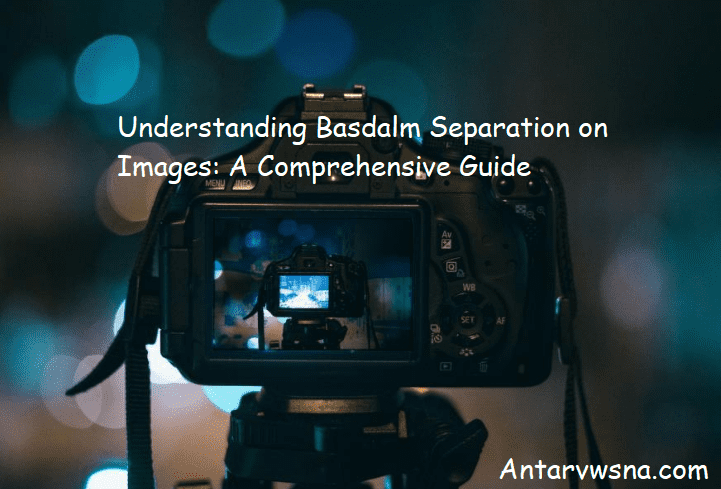Introduction
In today’s visually-driven world, the importance of clear and impactful images cannot be overstated. Whether for marketing, education, or personal projects, the way images are presented can significantly influence audience perception. One crucial technique that enhances image quality and clarity is Basdalm Separation on Images. This guide aims to unravel the intricacies of Basdalm Separation, its applications, benefits, and techniques, making it an essential read for photographers, designers, and anyone interested in improving their visual content.
What is Basdalm Separation on Images?
Basdalm Separation on Images refers to a technique used in image processing that allows for the extraction of distinct elements within an image. This separation enables a clearer focus on specific components, improving the overall quality and effectiveness of the image. It involves isolating layers of an image to enhance details, making it easier to manipulate individual parts without affecting the entire picture.
The Importance of Basdalm Separation
The significance of Basdalm Separation on Images can be seen in various fields:
1. Photography:
Photographers use this technique to enhance portraits by separating the subject from the background, creating a more professional and polished look.
2. Graphic Design:
Designers utilize image separation to create visually appealing compositions, allowing for better control over each layer and element.
3. Digital Marketing:
In marketing, clear and engaging visuals are crucial. Basdalm Separation helps businesses create images that attract attention and convey messages effectively.
4. Education:
In educational materials, clear separation of images helps students focus on key concepts, aiding in comprehension and retention.
How Basdalm Separation Works
Step 1: Analyzing the Image
Before applying Basdalm Separation, it’s essential to analyze the image. Look for the elements that need to be isolated. This could be subjects, objects, or even backgrounds. Understanding the composition will guide the separation process.
Step 2: Choosing the Right Tools
Several tools can facilitate Basdalm Separation on Images. Some popular software includes:
- Adobe Photoshop: Offers a wide range of tools for layer ofmanipulation and separation.
- GIMP: A free alternative to Photoshop that provides powerful image editing capabilities.
- Canva: While primarily a design tool, it offers some separation features for simpler projects.
Step 3: Layering
Once the tools are selected, the next step is layering. This involves duplicating the original image layer and isolating the elements you want to separate. For instance, if you’re focusing on a person in a portrait, you would create a new layer that contains only the person.
Step 4: Masking
Masking is a crucial part of Basdalm Separation on Images. It allows you to hide or reveal parts of an image layer. By applying a mask, you can refine the edges of the isolated elements, ensuring a smooth transition between layers. This step is vital for maintaining realism in the final image.
Step 5: Refining Edges
Refining edges is essential to create a natural look. Use feathering techniques to soften the edges of the separated elements. This helps blend them into the background or other layers, making the final image more cohesive.
Step 6: Adjusting Colors and Effects
After successfully separating the elements, you can enhance colors, brightness, and effects. This is where you can apply filters or adjustments to make certain parts of the image stand out, emphasizing the subject and improving the overall visual appeal.
Step 7: Finalizing the Image
Once you’re satisfied with the separation and adjustments, it’s time to finalize the image. Save your work in the desired format, ensuring it meets the requirements for its intended use, whether for print, online sharing, or other purposes.

Applications of Basdalm Separation
1. Portrait Photography
In portrait photography, Basdalm Separation on Images is used to create stunning portraits by separating the subject from distracting backgrounds. This technique enhances focus on the subject, resulting in a more impactful visual narrative.
2. Product Images
For e-commerce businesses, clear product images are vital. By applying Basdalm Separation, product images can be isolated from their backgrounds, making them more appealing to potential buyers. This technique ensures that customers see the product clearly, leading to better sales conversions.
3. Infographics and Visual Content
Infographics benefit greatly from image separation. By isolating key elements, designers can create compelling visuals that communicate complex information simply and effectively. This helps retain viewer attention and improves information retention.
4. Social Media Content
Social media thrives on visually appealing content. Using Basdalm Separation on Images, creators can produce eye-catching graphics that stand out in crowded feeds. This increases engagement and encourages shares, boosting the content’s reach.
5. Marketing Materials
In marketing, images are often the first point of contact with potential customers. Utilizing Basdalm Separation enhances marketing materials, making them more professional and visually appealing. This technique helps in crafting images that align with the brand’s message and aesthetic.
Benefits of Basdalm Separation
1. Enhanced Focus
One of the primary benefits of Basdalm Separation on Images is the enhanced focus it provides. By isolating specific elements, viewers can easily direct their attention to the most important aspects of the image.
2. Improved Quality
Separation techniques often lead to higher quality images. By refining edges and adjusting colors independently, the final image is sharper and more polished, resulting in a professional look.
3. Greater Creative Control
With image separation, creators gain greater control over the composition. This allows for experimentation with different layouts and designs, leading to more innovative and engaging visuals.
4. Flexibility
Basdalm Separation offers flexibility in image manipulation. Once elements are separated, they can be easily adjusted, moved, or modified without impacting the entire image. This is particularly useful in iterative design processes.
5. Time Efficiency
While the initial process of separation may require time, the long-term benefits include time efficiency in future projects. Once you master the technique, creating compelling visuals becomes quicker and more intuitive.
Common Challenges in Basdalm Separation
1. Complex Backgrounds
One challenge in Basdalm Separation on Images is dealing with complex backgrounds. Isolating elements from intricate backgrounds can be time-consuming and may require advanced techniques like the use of the pen tool or advanced masking.
2. Maintaining Quality
Ensuring that the quality of the separated elements remains high can be tricky, especially when scaling images. It’s crucial to work with high-resolution images to prevent pixelation and loss of detail during separation.
3. Learning Curve
For those new to image editing, mastering the tools and techniques for Basdalm Separation may take time. However, numerous tutorials and resources are available to help beginners navigate this learning curve.

Conclusion
In conclusion, Basdalm Separation on Images is a powerful technique that enhances the clarity and quality of visual content across various applications. Whether in photography, design, marketing, or education, mastering this technique can significantly improve how images are perceived and utilized. By understanding the principles and methods behind Basdalm Separation, you can unlock a new level of creativity and professionalism in your visual projects.
As you embark on your journey to master image separation, remember that practice and experimentation are key. With each project, you’ll refine your skills and develop your unique style. Embrace the possibilities that Basdalm Separation on Images offers, and watch your visual storytelling reach new heights!
FAQs
1. What is Basdalm Separation on Images?
Basdalm Separation on Images is a technique in image processing that isolates distinct elements within an image to enhance clarity and focus. This method allows creators to manipulate individual parts without affecting the entire image.
2. What tools can I use for Basdalm Separation on Images?
Popular tools for Basdalm Separation include Adobe Photoshop, GIMP, and Canva. These software options offer various features that facilitate layer manipulation and image editing.
3. How can I apply Basdalm Separation in photography?
In photography, Basdalm Separation can be used to isolate the subject from the background, improving the overall quality and impact of portraits. This technique enhances focus on the subject and creates a more professional look.
4. What are the benefits of using Basdalm Separation on Images?
The benefits include enhanced focus on key elements, improved image quality, greater creative control, flexibility in image manipulation, and increased efficiency in producing high-quality visuals.
5. Are there challenges associated with Basdalm Separation?
Yes, common challenges include dealing with complex backgrounds, maintaining image quality during separation, and the learning curve for beginners. However, these can be overcome with practice and the use of appropriate techniques.





